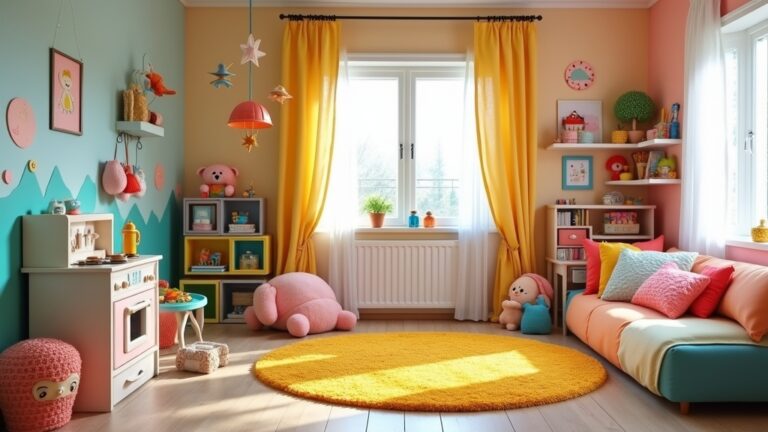Creating a fun playroom is easier than it seems. I recommend designating a dedicated play zone with engaging materials and textures. Utilize vertical storage solutions like shelves and baskets for easy access to toys. Incorporate multi-functional furniture to save space, and make a cozy reading nook for quiet time. Set up a craft corner for creativity, and use clear storage bins for organization. Establish a color-coded system for easy cleanup, and consider adding outdoor play elements. There’s more to explore!
Designate a Dedicated Play Zone
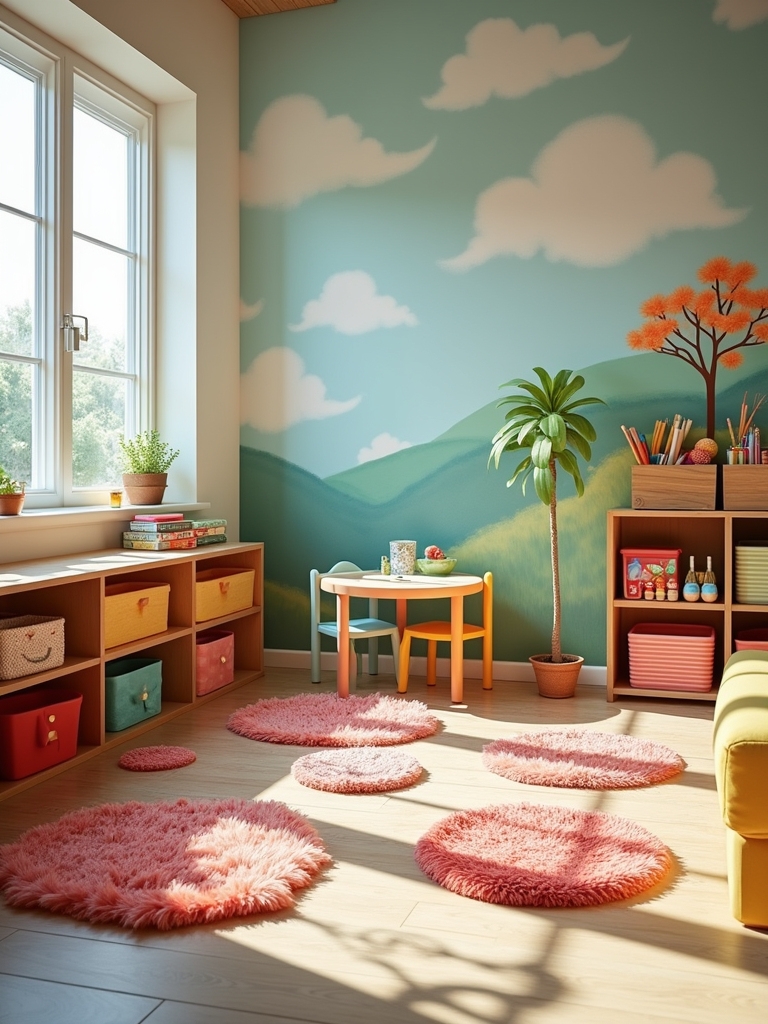
When it comes to creating a fun playroom, designating a dedicated play zone is essential. A well-thought-out play zone layout can enhance sensory play, encouraging creativity and exploration. I recommend using various materials and textures to engage different senses, like soft rugs and colorful wall art. Organize toys and activities to promote free play, making the space welcoming and stimulating for kids.
Utilize Vertical Space for Storage
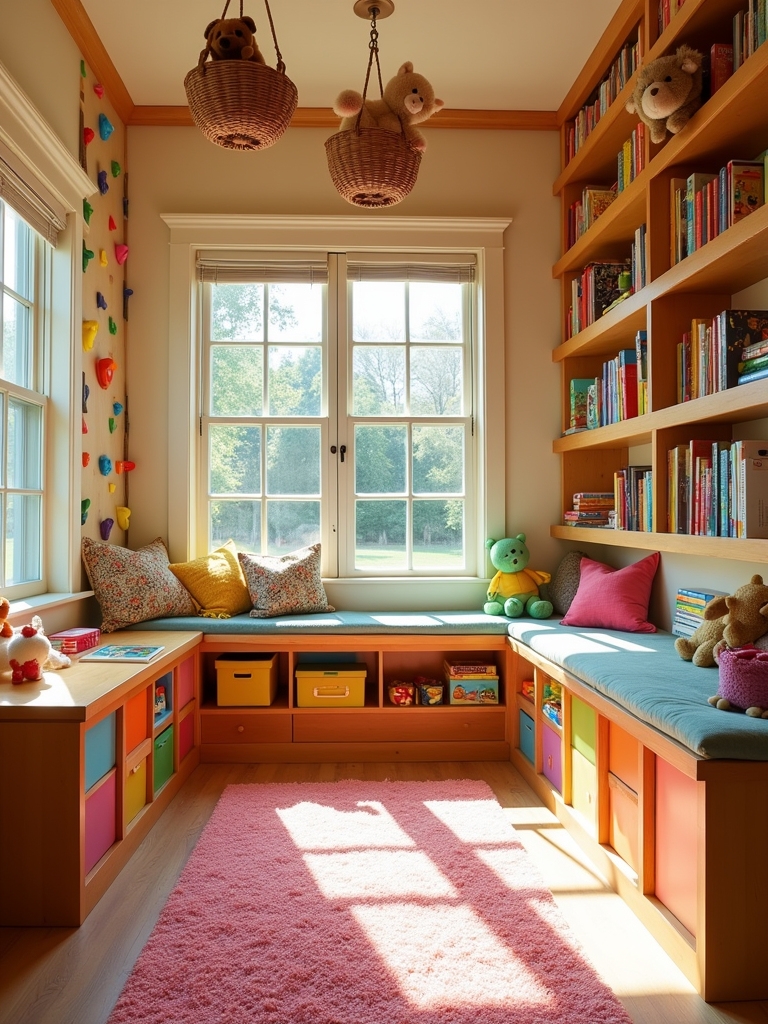
To maximize the playroom’s functionality, I suggest utilizing vertical space for storage. Installing wall mounted shelves can help organize toys, books, and games efficiently, freeing up floor space. Consider using bins or baskets on these shelves for easy access. Vertical storage not only keeps items neatly arranged but also adds a creative element to the room’s design, making it visually appealing for everyone.
Incorporate Multi-Functional Furniture
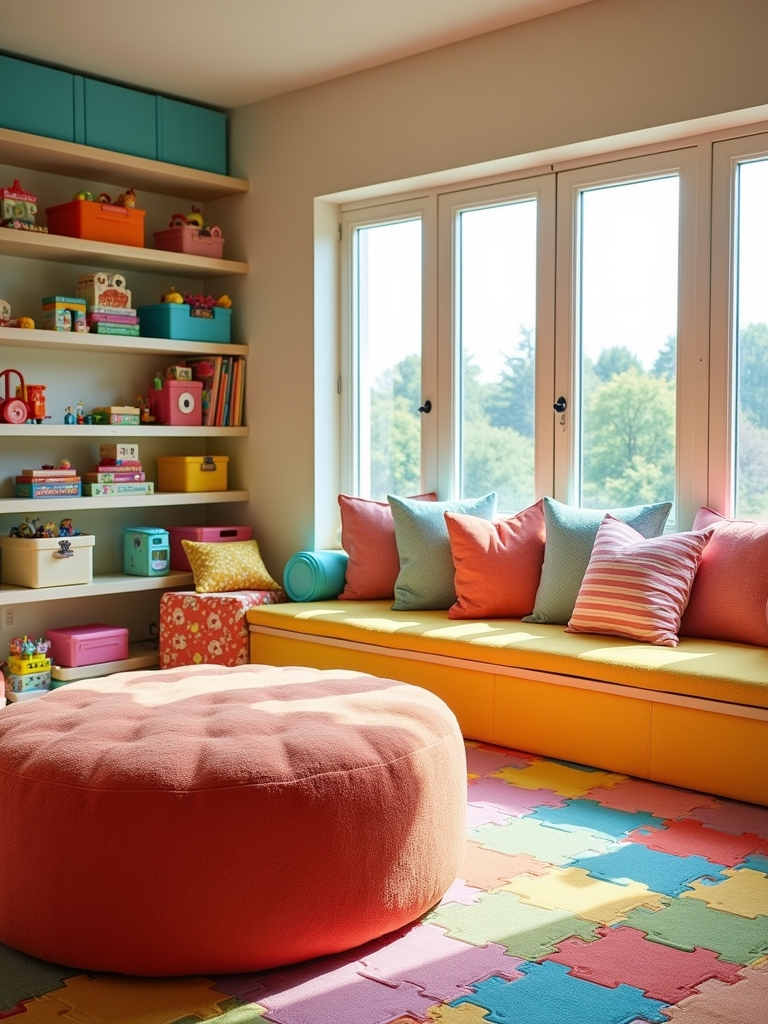
After organizing your playroom with vertical storage, it’s time to think about incorporating multi-functional furniture. Look for space-saving solutions like ottomans with hidden storage or tables that double as play surfaces. Furniture versatility can transform your playroom, making it adaptable for various activities. With the right pieces, you’ll maximize your space while keeping everything organized and easily accessible for your kids.
Create a Cozy Reading Nook
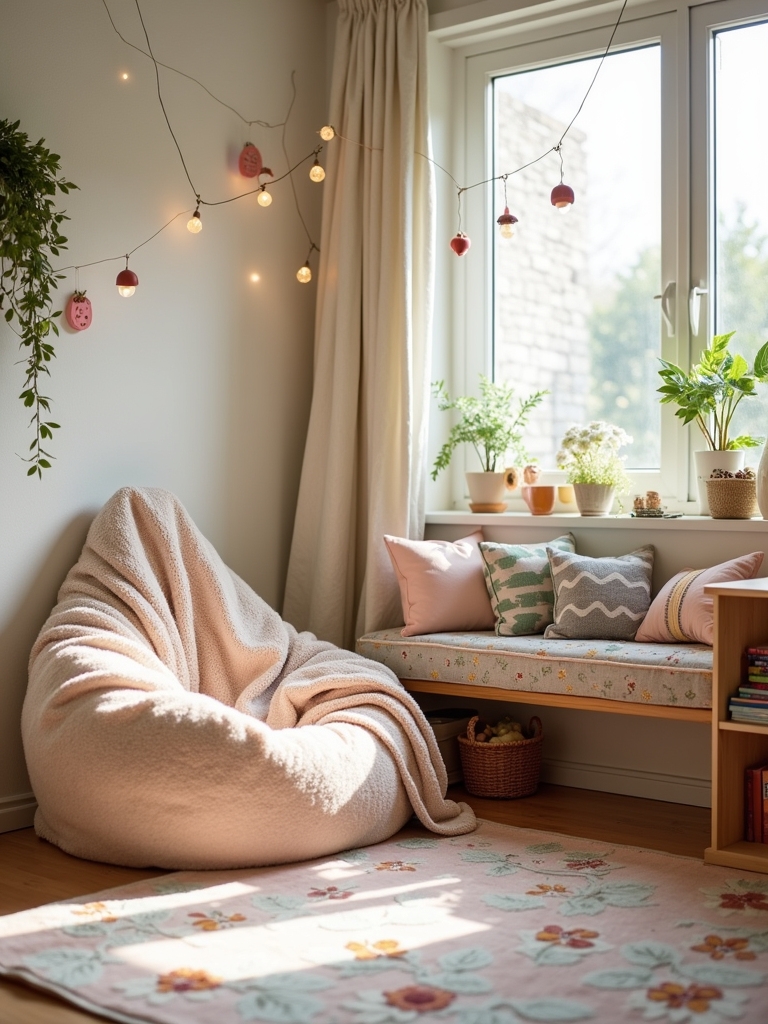
Creating a cozy reading nook can make a significant difference in your playroom, especially if your kids love to immerse themselves in books. Start by adding comfortable seating, like a bean bag or a small loveseat. Surround it with a variety of reading materials, such as picture books and chapter books. This inviting space encourages quiet exploration and helps foster a lifelong love of reading.
Use Clear Storage Bins for Easy Access
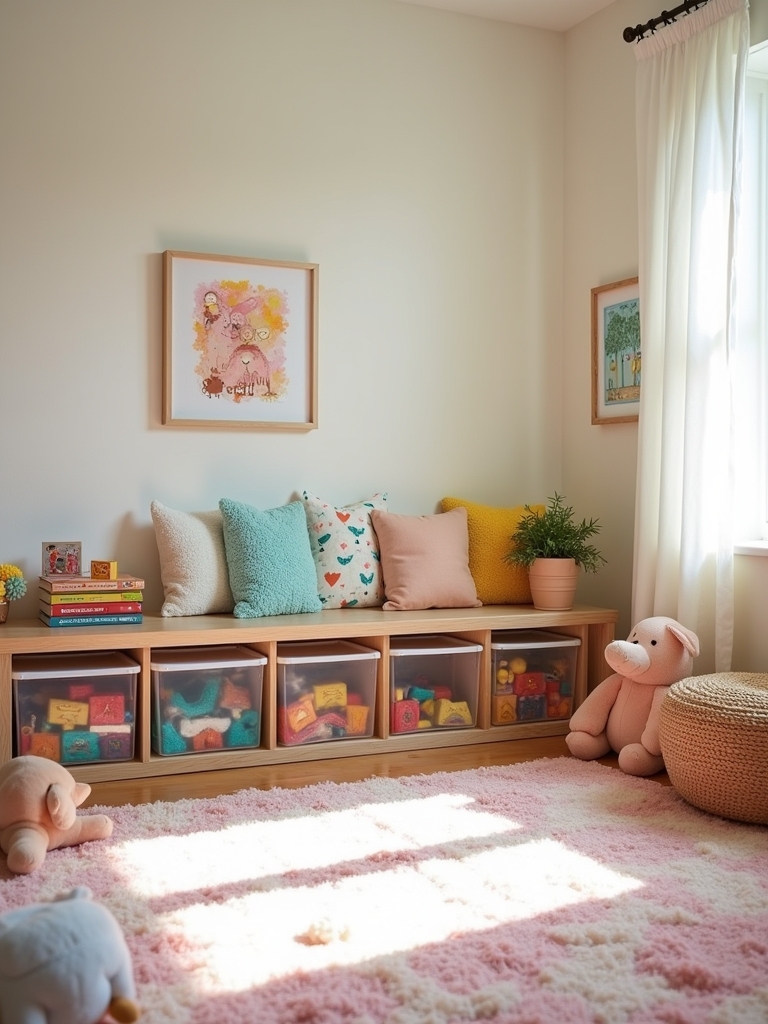
When it comes to organizing a playroom, using clear storage bins can make a big difference in how easily kids can find and access their toys. These bins are practical storage solutions that enhance toy organization. Here are three benefits to reflect on:
- Visibility of items
- Easy to label
- Stackable for space-saving
Using clear bins truly simplifies the playroom experience!
Establish Activity Stations
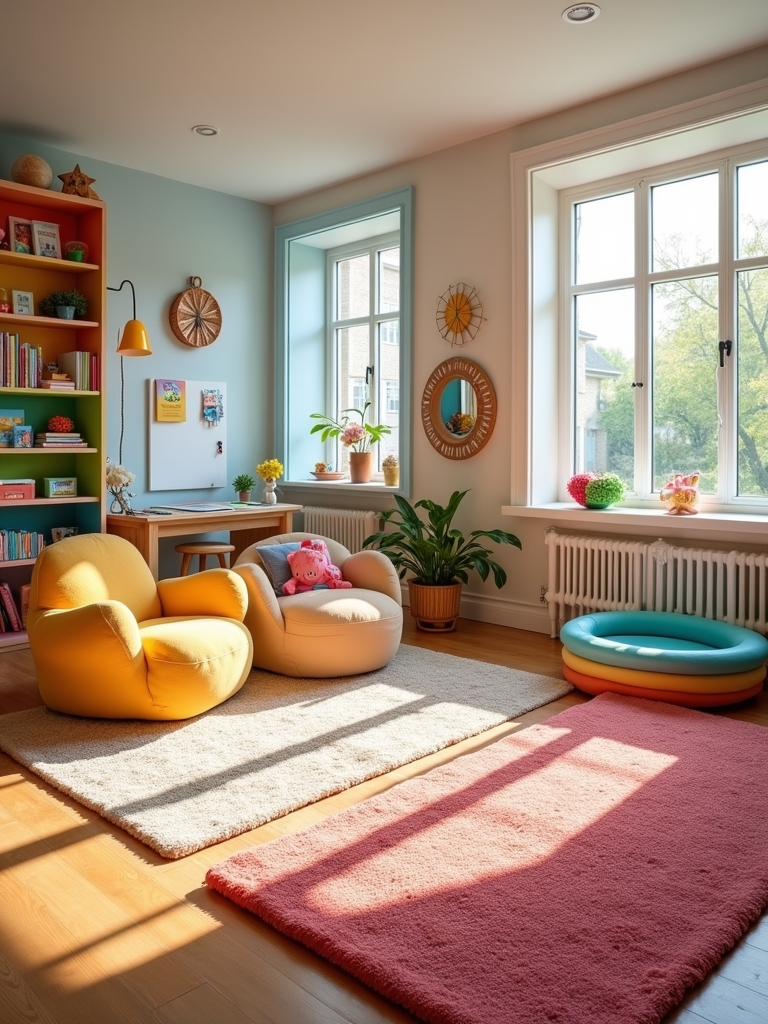
Establishing activity stations in a playroom not only encourages kids to engage in different types of play, but it also helps organize their space effectively. By setting up areas dedicated to arts and crafts, sensory exploration, or building, I can promote activity rotation. This approach keeps kids interested and allows them to develop a variety of skills while having fun in a structured environment.
Implement a Color-Coded Organization System
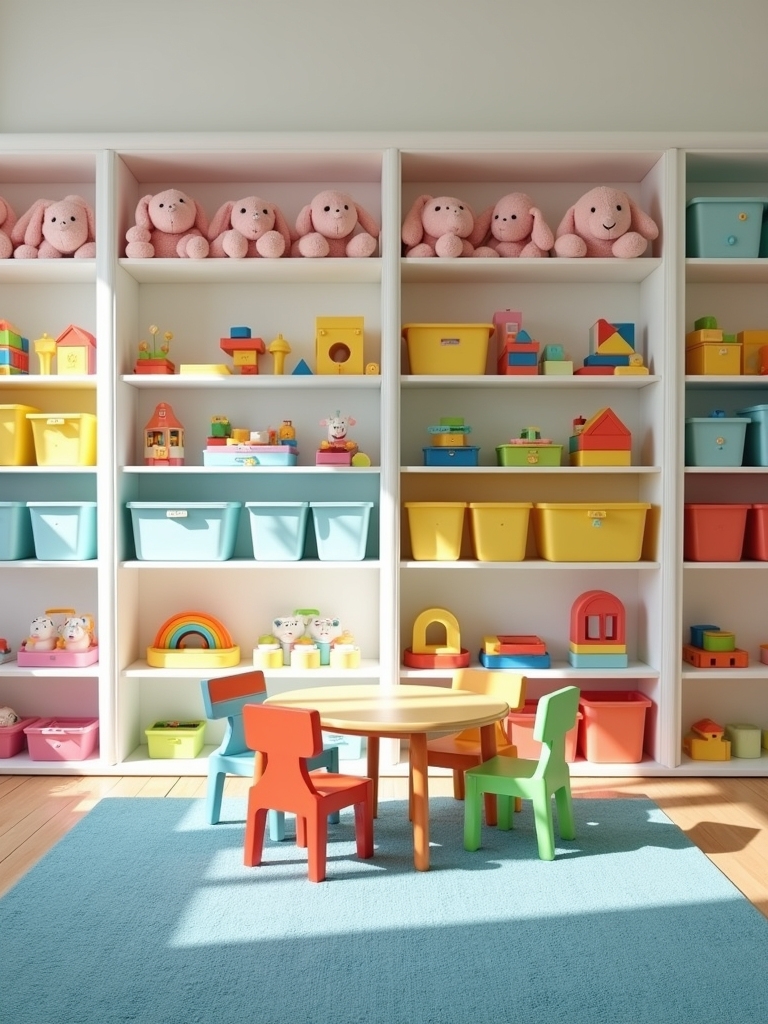
Implementing a color-coded organization system can make it easier for kids to find and put away their toys. By using distinct color themes, you can simplify sorting methods. Consider these three steps:
- Assign a color to each toy category.
- Use matching bins for storage.
- Encourage kids to sort their toys by color.
This approach fosters independence while keeping the playroom organized.
Add a Chalkboard Wall for Creativity
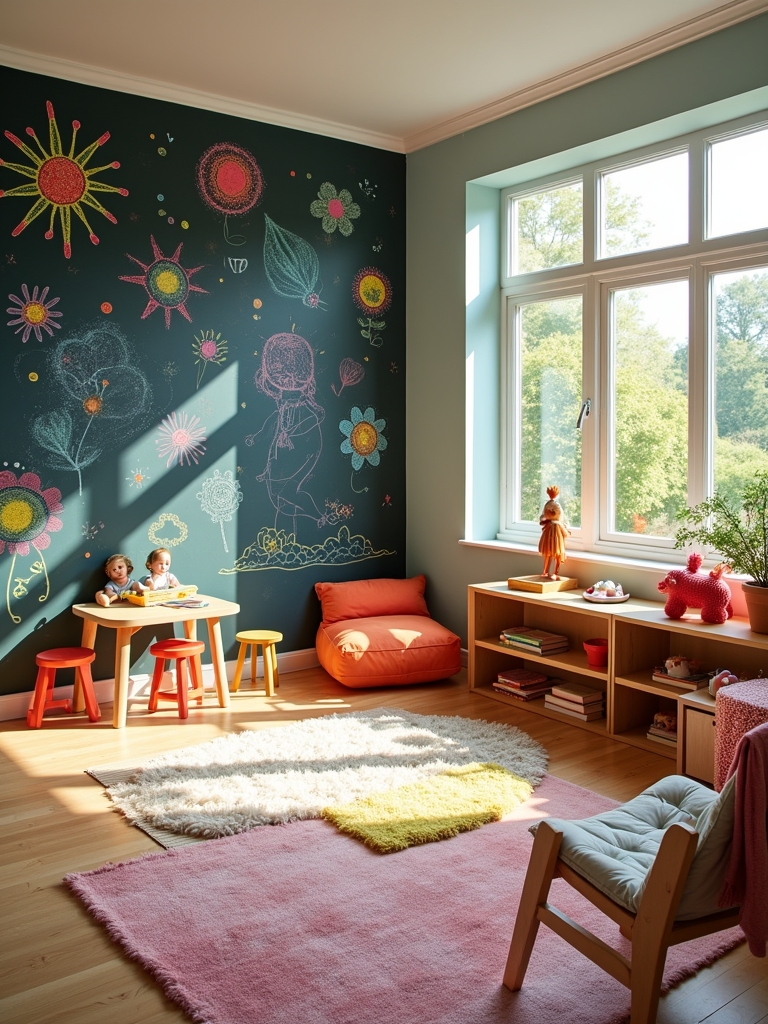
A chalkboard wall can be a fantastic addition to any playroom, serving as a blank canvas for kids’ creativity. It encourages chalkboard art and allows for endless creative expression. Plus, it’s easy to clean up! Here are a few ideas to get started:
| Idea | Benefits |
|---|---|
| Doodle Zone | Promotes imagination |
| Learning Space | Supports educational activities |
| Storyboard Area | Encourages storytelling |
| Game Board | Fun for family games |
| Art Gallery | Showcases kids’ artwork |
Include Soft Flooring for Safety
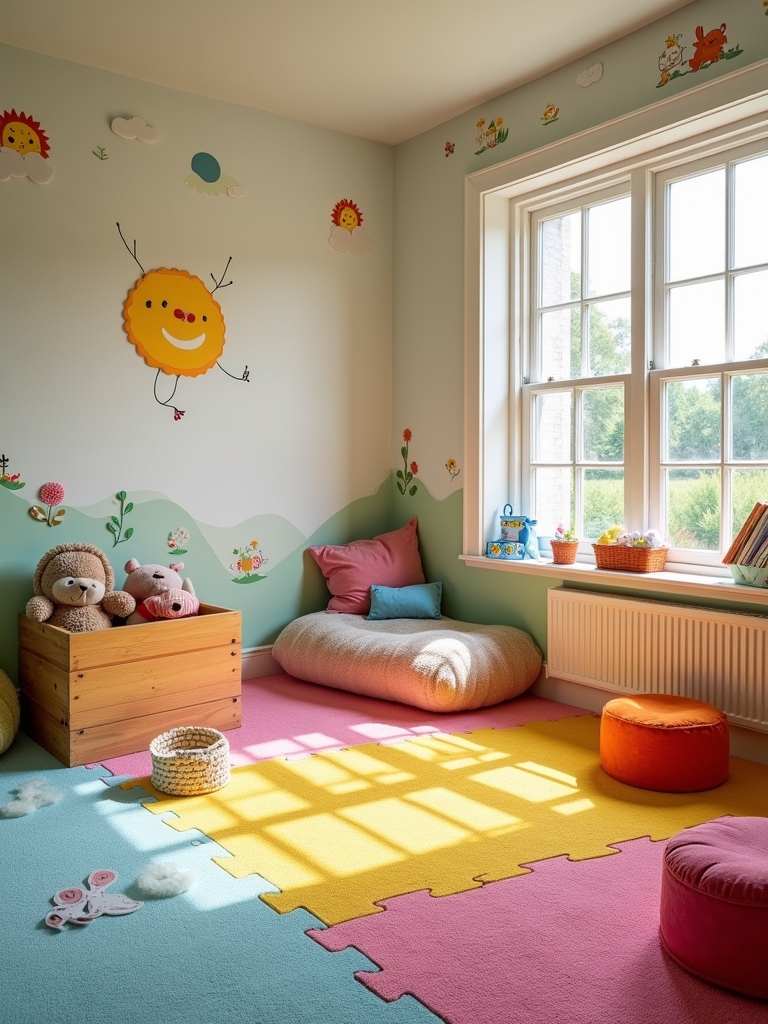
When creating a safe playroom, one key element I always recommend is including soft flooring. This guarantees that your little ones can play freely without the risk of injury. Here are three soft surface options to take into account:
- Foam tiles
- Carpeting
- Area rugs
Personalize the Space With Artwork
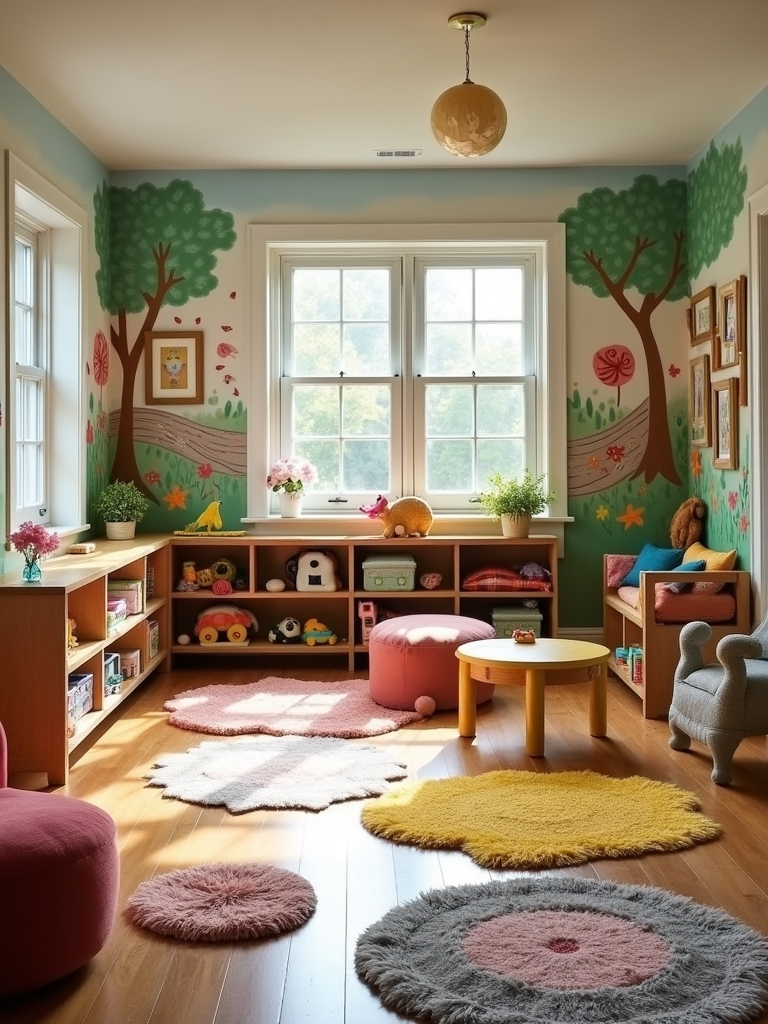
Adding artwork to your playroom can truly transform the space and make it feel unique. I love using custom art displays to showcase my kids’ creativity, while themed wall decals can bring their favorite stories to life. These elements not only add color but also create a personalized environment that inspires imagination and play, making every corner of the room special.
Rotate Toys for Fresh Engagement
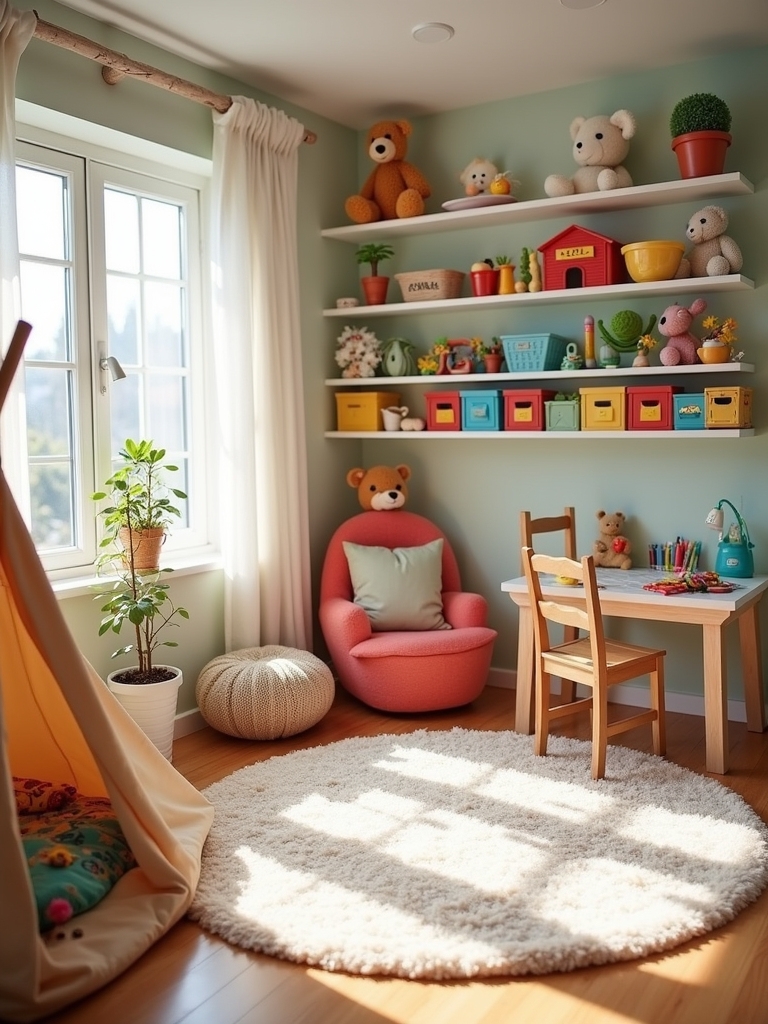
Creating a vibrant playroom is just the start; keeping it engaging is key. To implement effective toy rotation as an engagement strategy, try these ideas:
- Set a schedule for rotating toys every few weeks.
- Group toys by theme or type for varied play experiences.
- Involve your child in choosing which toys to swap out, boosting excitement and curiosity.
Set Up a Craft Corner
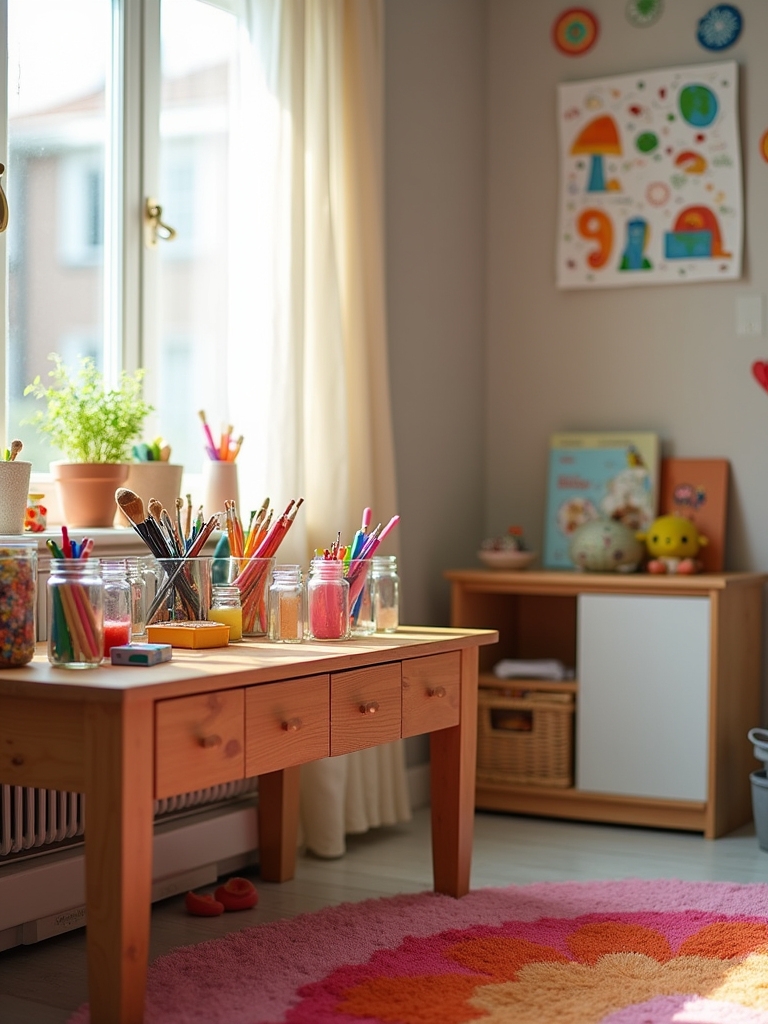
Setting up a craft corner can transform a playroom into a creative haven where imagination thrives. I suggest gathering various craft supplies like paper, markers, and glue, and organizing them creatively. Use bins or shelves to keep everything accessible and neat. This not only sparks creativity but also encourages kids to engage in hands-on activities, making playtime both fun and productive.
Use Labels for Easy Cleanup
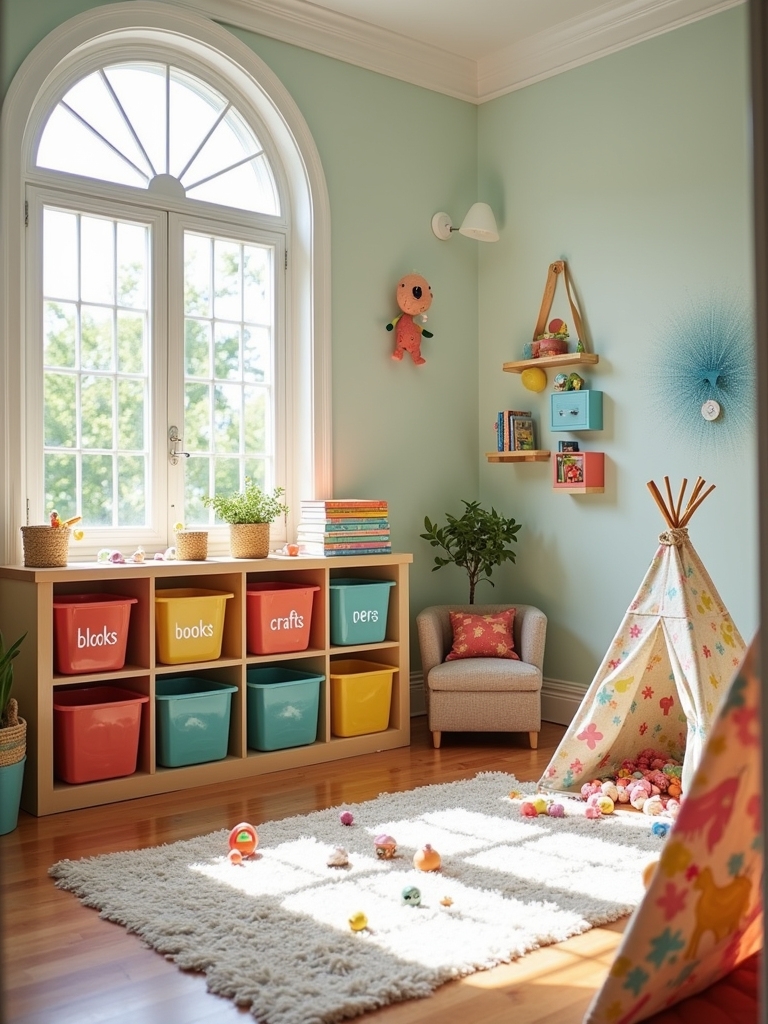
After establishing a craft corner, the next step is to reflect on how to keep the playroom organized. Effective labeling strategies can transform cleanup routines, making them simpler for everyone. Here are three ideas to contemplate:
- Color-coded bins for different toys
- Picture labels for younger kids
- Clear containers for easy visibility
These solutions can streamline playtime and encourage kids to help tidy up!
Create an Outdoor Play Area
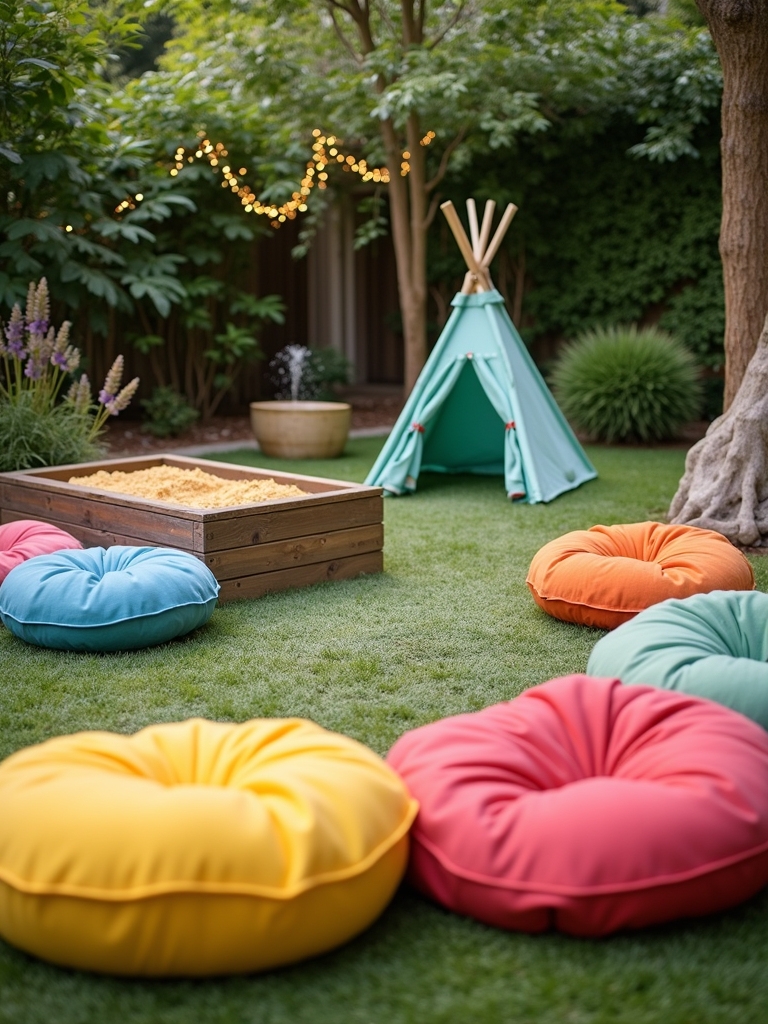
While it may seem challenging to create an outdoor play area, it can be a rewarding addition to your home that encourages active play and exploration. Setting up a space for outdoor games and nature exploration provides children with fresh air and physical activity. Here’s a simple table to inspire your design:
| Feature | Ideas | Benefits |
|---|---|---|
| Play Equipment | Swing set | Builds strength |
| Nature Area | Garden bed | Teaches responsibility |
| Activity Zone | Obstacle course | Enhances agility |
| Seating Area | Picnic table | Encourages socializing |
| Sensory Path | Different textures | Stimulates senses |
Encourage Imaginative Play With Props
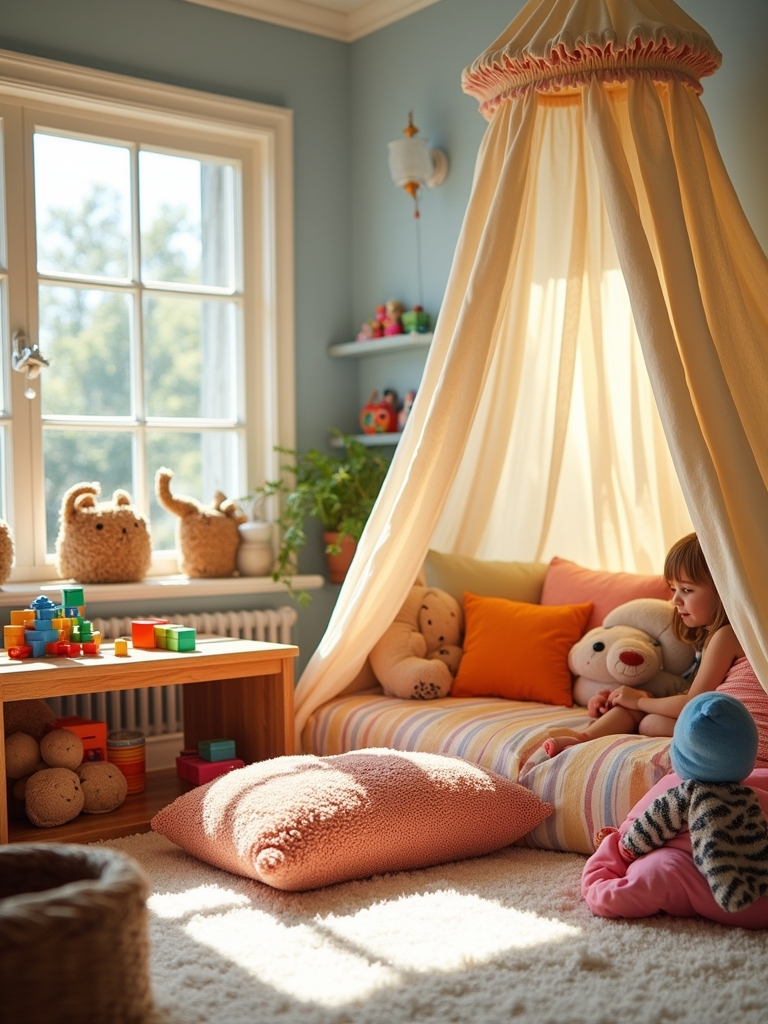
Creating an outdoor play area can spark creativity, but imaginative play doesn’t have to stop there. You can elevate playtime with a few simple props. Consider adding:
- A dress-up box with themed costumes for role play.
- A puppet theater for storytelling and performances.
- Sensory bins filled with art supplies and building blocks to inspire creativity.
These ideas can lead to unforgettable imaginative playdates!
Frequently Asked Questions
How Do I Choose the Right Colors for a Playroom?
When choosing colors for a playroom, I consider color psychology and vibrant combinations. I mix energizing hues like yellow and blue to inspire creativity, while softer tones create a calming atmosphere, balancing fun and relaxation effectively.
What Safety Measures Should I Consider for a Playroom?
When I think about safety in a playroom, I envision a fortress of creativity. I prioritize childproofing strategies like soft edges and safety equipment, ensuring my little one’s adventures remain joyful and secure.
How Can I Involve My Kids in Organizing the Playroom?
To boost playroom organization, I involve my kids by letting them choose storage solutions and deciding where their toys go. Their creativity makes it fun, and they take pride in their space, fostering responsibility.
What Age-Appropriate Toys Should I Include in the Playroom?
Choosing age-appropriate toys feels like crafting a masterpiece. I love including educational toys that spark curiosity and sensory play options, ensuring my kids engage their minds and senses while having fun exploring their creativity together.
How Often Should I Rotate Toys for Engagement?
I rotate toys every few weeks to maintain engagement. This toy rotation strategy keeps things fresh and exciting, encouraging my child’s creativity and exploration. It’s an innovative way to maximize playtime and learning opportunities!
Conclusion
Creating a playroom that sparks joy and creativity can be simple. By designating a specific area, using smart storage solutions, and encouraging imaginative play, you can transform any space into a fun haven. Incorporating cozy nooks and clear organization makes cleanup a breeze and keeps the fun flowing. With these ideas, you’re not just setting up a playroom; you’re crafting a vibrant world where kids can explore, create, and grow, all while enjoying stress-free play.

